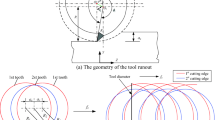Abstract
This paper investigates multiple modeling choices for analyzing the rich and complex dynamics of high-speed milling processes. Various models are introduced to capture the effects of asymmetric structural modes and the influence of nonlinear regeneration in a discontinuous cutting force model. Stability is determined from the development of a dynamic map for the resulting variational system. The general case of asymmetric structural elements is investigated with a fixed frame and rotating frame model to show differences in the predicted unstable regions due to parametric excitation. Analytical and numerical investigations are confirmed through a series of experimental cutting tests. The principal results are additional unstable regions, hysteresis in the bifurcation diagrams, and the presence of coexisting periodic and quasiperiodic attractors which is confirmed through experimentation.
Similar content being viewed by others
References
Tlusty, J., Manufacturing Processes and Equipment., 1st edn., Prentice Hall, Upper Saddle River, NJ, 2000.
Altintas, Y., Manufacturing Automation., 1st edn., Cambridge University Press, New York, 2000.
Nayfeh, A. H. and Mook, D. T., Nonlinear Oscillations., Wiley, New York, 1979.
Davies, M. and Balachandran, B. ‘Impact dynamics in milling of thin-walled structures,’ Nonlinear Dynamics. 22., 2001, 375–392.
Mann, B. P., Bayly, P. V., Davies, M. A., and Halley, J. E., ‘Limit cycles, bifurcations, and accuracy of the milling process,’ Journal of Sound and Vibration. 277., 2004, 31–48.
Doi, S. and Kato, S. ‘Chatter vibration of lathe tools,’ Transactions of the ASME. 78., 1956, 1127–1134.
Tlusty, J., Polacek, A., Danek, C., and Spacek, J., Selbsterregte Schwingungen an Werkzeugmaschinen., VEB Verlag Technik, Berlin, 1962.
Tobias, S. A., Machine Tool Vibration., Blackie, London, 1965.
Merritt, H., ‘Theory of self-excited machine tool chatter,’ Journal of Engineering for Industry. 87.(4), 1965, 447–454.
Smith, S. and Tlusty, J., ‘An overview of the modeling and simulation of the milling process,’ Journal of Engineering for Industry. 113., 1991, 169–175.
Montgomery, D. and Altintas, Y., ‘Mechanism of cutting force and surface generation in dynamic milling,’ Journal of Engineering for Industry. 113., 1991, 160–168.
Davies, M. A., Pratt, J. R., Dutterer, B., and Burns, T. J., ‘Stability prediction for low radial immersion milling,’ Journal of Manufacturing Science and Engineering. 124.(2), 2002, 217–225.
Davies, M. A., Pratt, J. R., Dutterer, B., and Burns, T. J., ‘The stability of low immersion milling,’ Annals of the CIRP. 49., 2000, 37–40.
Bayly, P. V., Halley, J. E., Mann, B. P., and Davies, M. A., ‘Stability of interrupted cutting by temporal finite element analysis,’ in Proceedings of the 18th Biennial Conference on Mechanical Vibration and Noise, Pittsburg, PA., 2001.
Insperger, T. and Stépán, G., ‘Stability of high-speed milling,’ in Proceedings of Symposium on Nonlinear Dynamics and Stochastic Mechanics., Orlando, FL, AMD-241, 2000, pp. 119–123.
Corpus, W. T. and Endres, W. J., ‘A high order solution for the added stability lobes in intermittent machining,’ in Proceedings of the Symposium on Machining Processes., Orlando, FL, (MED-11), 2000, pp. 871–878.
Zao, M. X. and Balachandran, B., ‘Dynamics and stability of milling process,’ International Journal of Solids and Structures. 38., 2001, 2233–2248.
Bayly, P. V., Mann, B. P., Schmitz, T. L., Peters, D. A., Stépán, G., and Insperger, T., ‘Effects of radial immersion and cutting direction on chatter instability in end-milling,’ in Proceedings of ASME Engineering Congress and Exposition, New Orleans, LA., 2002.
Mann, B. P., Insperger, T., Bayly, P. V., and Stépán, G., ‘Stability of up-milling and down-milling, Part 2: Experimental verification,’ International Journal of Machine Tools and Manufacture. 43., 2003, 35–40.
Insperger, T., Mann, B. P., Stépán, G., and Bayly, P. V., ‘Stability of up-milling and down-milling, Part 1: Alternative analytical methods,’ International Journal of Machine Tools and Manufacture. 43., 2003, 25–34.
Insperger, T., Stépán, G., Bayly, P. V., and Mann, B. P., ‘Multiple chatter frequencies in milling processes,’ Journal of Sound and Vibration. 262., 2003, 333–345.
Balachandran, B., ‘Non-linear dynamics of milling process,’ Philosophical Transactions of the Royal Society of London A. 359., 2001, 793–819.
Bayly, P. V., Halley, J. E., Davies, M. A., and Pratt, J. R., ‘Stability analysis of interrupted cutting with finite time in the cut,’ in Proceedings of ASME Design Engineering Technical Conference, Manufacturing in Engineering Division., Orlando, FL, 2001.
Bayly, P., Halley, J., Mann, B., and Davies, M., ‘Stability of interrupted cutting by temporal finite element analysis,’ Journal of Manufacturing Science and Engineering. 125., 2003, 220–225.
Stépán G., ‘Modelling nonlinear regenerative effects in metal cutting,’ Philosophical Transactions of the Royal Society of London A. 359., 2001, 739–757.
Davies M. and Burns, T., ‘Thermomechanical oscillations in material flow during high-speed machining,’ Philosophical Transactions of the Royal Society of London A. 359., 2001, 821–846.
Grabec, I., ‘Chaotic dynamics of the cutting process,’ International Journal of Machine Tools and Manufacture. 28., 1988, 19–32.
Altintas, Y. and Budak, E., ‘Analytical prediction of stability lobes in milling,’ CIRP Annals. 44.(1), 1995, 357–362.
Hanna, N. H. and Tobias, S. A., ‘A theory of nonlinear regenerative chatter,’ Journal of Engineering for Industry. 96., 1974, 247–255.
Nayfeh, A. H., Chin, C. M., and Pratt, J., ‘Applications of Perturbation Methods to Tool Chatter Dynamics.,’ in Dynamics and Chaos in Manufacturing Processes., Wiley, New York, 1997.
Stephenson, D. A. and Agapio, J. S., Metal Cutting Theory and Practice., 1st edn., Marcel Dekker, New York, 1997,
Jaluria, Y., Computational Heat Transfer., 1st edn., Hemisphere Publishing Corporation, Washington, 1986.
Peters, D. A. and Idzapanah, A. P., ‘HP-version finite elements for the space-time domain,’ Computational Mechanics. 3., 1988, 73–78.
Virgin, L. N., Introduction to Experimental Nonlinear Dynamics., Cambridge University Press, Cambridge, UK, 2000.
Yamamoto, T. and Ishidam, Y., Linear and Nonlinear Rotordynamics., Wiley Series in Nonlinear Science, Wiley, New York, 2001.
Xie, A. and Dai, H., ‘On the sensitivity of multiple eigenvalues of nonsymmetric matrix pencils,’ Linear Algebra and Its Applications. 374., 2003, 143–158.
Author information
Authors and Affiliations
Corresponding author
Rights and permissions
About this article
Cite this article
Mann, B.P., Garg, N.K., Young, K.A. et al. Milling Bifurcations from Structural Asymmetry and Nonlinear Regeneration. Nonlinear Dyn 42, 319–337 (2005). https://doi.org/10.1007/s11071-005-5719-y
Received:
Accepted:
Issue Date:
DOI: https://doi.org/10.1007/s11071-005-5719-y




